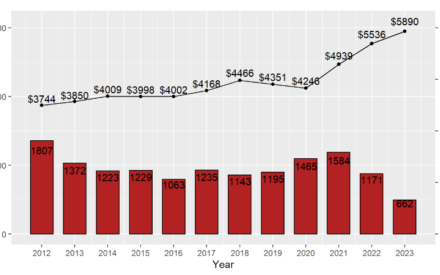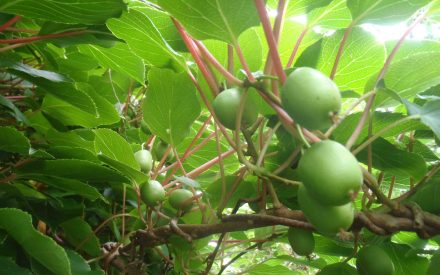Farm buildings and land often last longer than the owner has a need for them, but may still be usable by other farmers. These farmers, especially beginning farmers, may not be in a position to invest in new or upgrade existing facilities. Both parties may benefit by entering into a landlord-tenant relationship. The owner may receive a return on property that might otherwise remain idle or be underutilized. The farmer may use the property without making a large fixed investment. However, the owner (landlord) and the farmer (tenant) must agree on various elements when developing a rental agreement for crop or livestock buildings or farm land.
The landlord and tenant need to discuss improvements and repairs of the property before the lease begins. There is no right answer as to who should pay for what. A written lease detailing the responsibility of each party and agreeing to these items ahead of time will make the landlord-tenant relationship less troublesome.
Maintenance and Repairs
Most farm buildings will need maintenance and repairs at some point in time. At the beginning of the lease, the landlord and tenant should jointly inspect the rental property to be sure both parties are on the same page regarding the condition and working order of the buildings. In general, it is the owner’s responsibility to have the property in good condition when the lease begins. A lease may contain a trial period or a certain amount of time at the beginning which the owner agrees to repair any part of the property that is not in working order. This is especially important when equipment or property has not been used recently.
In addition, before entering into a lease, the owner and farmer need to agree on how future maintenance and repair costs will be handled. The lease should specify who is responsible for maintaining and making repairs to the property that are included in the lease. Also, the lease should state who is responsible for maintenance or keeping the property and all its fixtures in working condition.
The landlord and tenant should specify the types of repairs the landlord will be required to make, and the level of maintenance required of the tenant. The lease agreement should also specify how the tenant may be reimbursed for necessary repairs, such as whether the tenant receives a rent deduction for making repairs, or whether the landlord is required to provide supplies for repairs and the tenant contributes the labor.
Some leases allow the tenant to charge repairs up to a maximum dollar amount without prior approval, but amounts over this limit must be approved by the owner before the repairs are done. A maintenance schedule may be included with a lease agreement that provides details as to how and when repairs and maintenance should be done, whose responsibility it is to pay for the costs, and whose responsibility it is to perform the task.
Here are a few examples of some standard ways that an owner and farmer may assign maintenance and repair responsibilities according to Farm Commons.
| Landlord’s Responsibility | Tenant’s Responsibility |
| Property taxes and assessments | Taxes related to ag production and sales taxes |
|
Liability insurance Property insurance on buildings Crop insurance (only if crop share lease or custom farming contract) |
Liability insurance Property insurance on personal property, buildings (only if required by landlord) Crop insurance |
| Repairs of major problems1 | Repairs of minor problems and maintenance2 |
| Maintenance of common areas utilized by multiple parties | Utilities |
| Conservation practices |
1 Major problems might include water supply systems (well pump), structural components (siding or roofing of barn, fences), waste treatment systems, heating and ventilation systems.
2 Minor problems might include routine maintenance of equipment, upkeep to prevent deterioration of buildings and other facilities, and repairs of fences, terraces, ditches, etc.
What is the difference between repairs and improvements?
The Internal Revenue Service (IRS) has information to determine whether an expense is a deductible repair for income tax purposes or a capital improvement. Generally, a repair is an expense that keeps the property in its ordinary, efficient, operating condition or restores the property to its original operating condition. A capital improvement materially enhances the value of the property or substantially prolongs its useful life. Adapting a property to a new or different use is also considered a capital improvement. The tenant may be able to deduct the cost of repairs from income for income tax purposes. In contrast, the owner’s expense for capital improvements may add to his or her tax basis in the property. Owner’s may be able to allocate these costs over several years as depreciation for income tax purposes. The owner and tenant should consult with their accountant or tax preparer regarding these tax implications.
Fixtures and Improvements
Before entering into a lease, the owner and farmer need to agree on the process that future alterations or improvements will be approved. The lease should specify what capital improvements the owner will allow on the property and who will pay for those improvements. Tenants may be interested in investing in long-term investments, but may be concerned about losing the investment if the lease is terminated early. A lease may contain a section regarding capital improvements, or a supplement to your lease agreement may be entered into to record the long-term investment.
Material for this article was adapted from information provided by Ag Lease 101. Ag Lease 101 helps both land owners and land operators learn about alternative lease arrangements and includes sample written lease agreements for several alternatives. Ag Lease 101 was created by and is maintained by the North Central Farm Management Extension Committee.
References:
- Edwards, W. (August 2013). Lease Supplement for Investing in Improvements on a Rented Farm, Iowa State University Extension Ag Decision Maker File C2-07.
- Farm Commons. Long-Term Agroforest Lease Workbook. “Checklist: Walking through Key Elements of a Long-Term Agroforestry Lease.”
- Land for Good. Maintenance, Repairs & Improvements Leasing Fact Sheet.
- Land for Good and UConn Extension. (2012). A Landowner’s Guide to Leasing Land for Farming.
- North Central Regional Cooperative Extension Services. (February 2013). Rental Agreements For Farm Buildings and Livestock Facilities, NVFMEC-04.
- Cannella, M., Waterman, B. (July 2014). How to Determine the Right Farm Rental Rate, University of Vermont Extension New Farmer Project.
Note: This article is intended to provide general information about legal issues in agricultural leasing and should not be construed as providing legal advice. It should not be cited or relied upon as legal authority. For advice about how the issues discussed here might apply to your individual situation, you should consult an attorney.

 Wisconsin Agricultural Land Prices 2024
Wisconsin Agricultural Land Prices 2024 Wisconsin Agricultural Land Prices 2023
Wisconsin Agricultural Land Prices 2023 Wisconsin Agricultural Land Prices 2022
Wisconsin Agricultural Land Prices 2022 Navigating Lease Agreements for Small Acreage, High Value Crops
Navigating Lease Agreements for Small Acreage, High Value Crops


